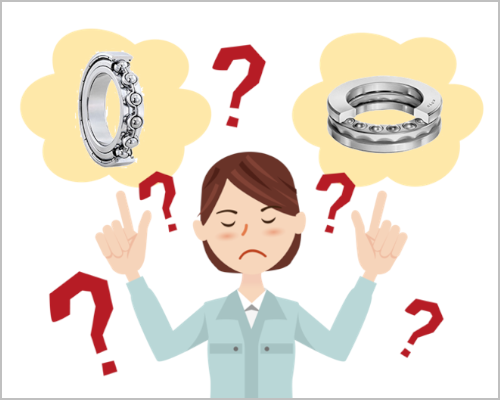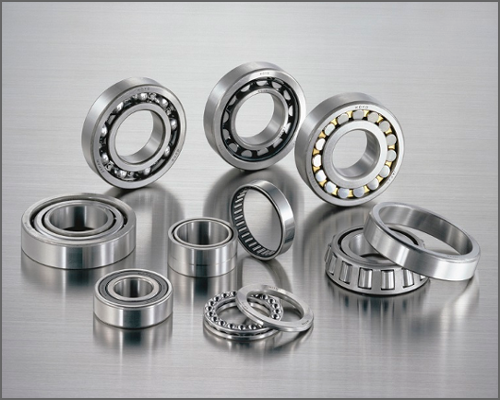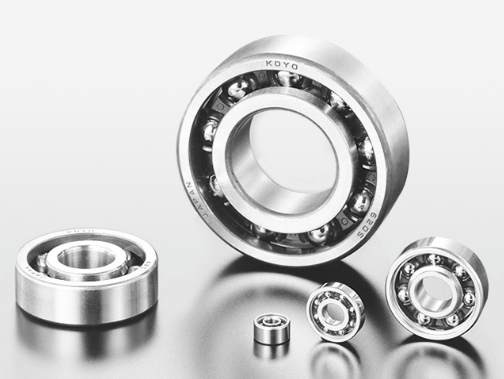Bearing Trivia
How to Select the Right Bearing (Part 1): The order of priority for selecting bearings, and the types of bearings
- #2 How to Select the Right Bearing
In previous Bearing Trivia entries, we introduced the fact that bearings are used in many machines and are a very important machine component. We focused in those columns on topics like bearing structure and so on.
"What's the Structure of the Bearing? The role of the structure and parts in reducing friction"
"What Are the Differences Between Bearings? The various types and special features of bearings"
When designing a machine, it is important to select the bearing that is right for that machine.
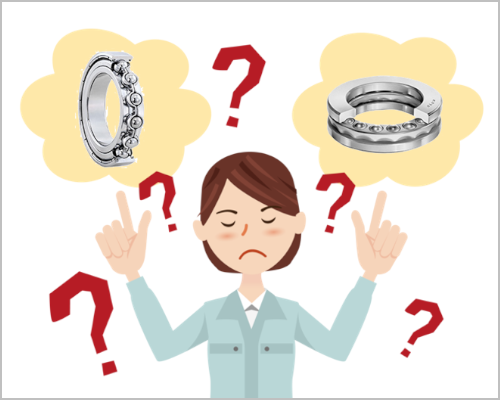
JTEKT has published a guide for selecting the right bearing in its Ball & Roller Bearings Catalog, but the catalog uses a large number of technical terms and is very long, so many people seem to have trouble handling it.
That's where this column comes in. We will explain the key points for selecting the type of bearing that is right for your machine.
The catalog uses the terms "bearing" and "rolling bearing" interchangeably. This column does not use the term "rolling bearing" as a general rule.
1. What are the criteria for selecting bearings?
Bearings come in a variety of types, and their sizes can range from just a few millimeters to over ten meters in diameter.。
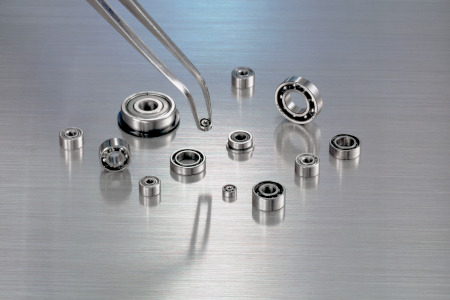 Fig. 1: Extra-small (miniature) bearings
Fig. 1: Extra-small (miniature) bearings
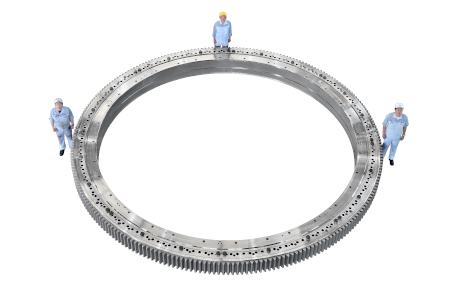 Fig. 2: Ultra large slewing rim bearing for tunnel excavators
Fig. 2: Ultra large slewing rim bearing for tunnel excavators
When selecting from among these many varied types of bearings, the bearing that is right for your machine, the following two criteria are very important.
- Criterion 1: It should be appropriate for the machine's usage environment and the operating condition that is being demanded of the bearing
- Criterion 2: It should be easy to acquire replacement bearings and it should facilitate maintenance/inspection of the machine
If these criteria are met, damage of the machine can be reduced, the time needed to replace the bearings when performing repairs can be shortened, and the machine can be used for a longer period of time.
In this way, selecting the appropriate bearing will lead to machine design that is economically superior!
2. The order of priority for selecting bearings
In the "How to Select the Right Bearing" columns, we will select the optimal bearing based on the ordering shown in Table 1, below.
Please note that the following order is only a guideline.
When you actually select the bearing to use, the most important factors are past success history and points of improvement, so it is not necessary to follow this order to the letter.
Table 1: Bearing selection checklist
| Order | Examination item | Major points to confirm |
|---|---|---|
| ① | Bearing type | What magnitude and direction of load do you need? Will it fit in the installation space? <This is the focus of Part 4> |
| ② | Bearing arrangement | Are you using two (or more) bearings on a single shaft? |
| ③ | Bearing dimensions and service life | Do the dimensions and service life satisfy your needs? |
| ④ | Bearing limiting speed, running accuracy, fits and internal clearance | Does it have the necessary running accuracy and rigidity for the machine? Does it have the fits and internal clearance to satisfy its service life? |
| ⑤ | Bearing preload and rigidity | Does it have the necessary rigidity for the machine? |
| ⑥ | Bearing lubrication | Can the bearing rotate stably over a long period of time? |
| ⑦ | Components around the bearing | What bearing surrounding structure/assembly are you looking for? |
| ⑧ | Bearing mounting and dismounting | Will it facilitate maintenance/inspection of the machine? |
3. How to select the type of bearing
When designing a machine, most people first decide on the dimensions of the shaft to satisfy the strength requirement, and then select the bearing based on that.
1) If the load will be mostly radial (perpendicular to the shaft), use a radial bearing, and if the load will be mostly axial* (same direction as the shaft), use a thrust bearing. * Axial loads are sometimes called thrust loads.
2) If the load on the bearing will be light, use a ball bearing, and if it will be heavy, use a roller bearing.
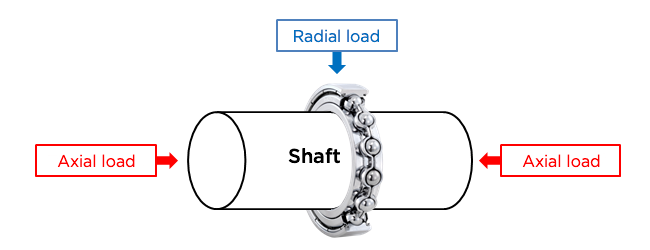 Fig. 3: The radial and axial loads
Fig. 3: The radial and axial loads
Table 2: The various types of bearings and loads placed on bearings
| Rolling element | |||
| Ball | Roller | ||
| Direction in which load is mostly applied | Perpendicular to the shaft (radial load) |
Radial ball bearing | Radial roller bearing |
| The same direction as the shaft (axial load) |
Thrust ball bearing | Thrust roller bearing | |
 Fig. 4: Radial bearings
Fig. 4: Radial bearings
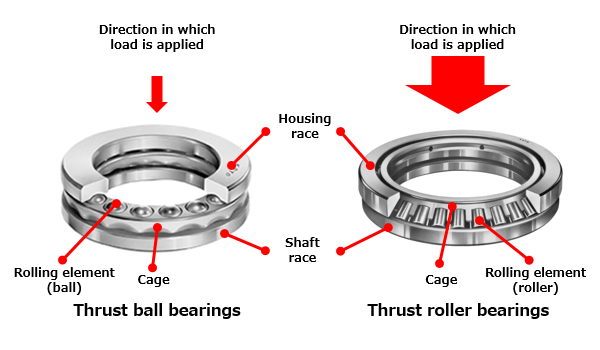 Fig. 5: Thrust bearings
Fig. 5: Thrust bearings
3) If a radial load and an axial load are both placed on a single bearing at the same time (combined load), a light combined load calls for a deep groove ball bearing or an angular contact ball bearing, while a heavy combined load calls for a tapered roller bearing.
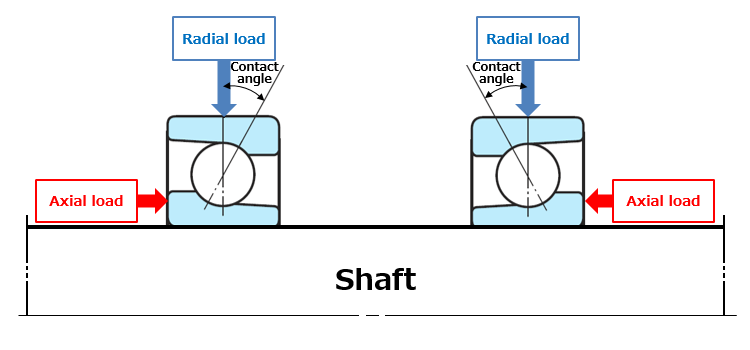 Fig. 6: The radial and axial loads (combined load) applied to an angular contact ball bearing
Fig. 6: The radial and axial loads (combined load) applied to an angular contact ball bearing
If there is a heavy axial load being applied from both directions, you can combine two or more bearings, or use a double-row bearing.
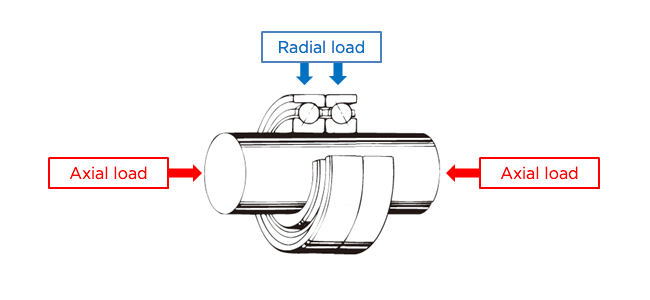 Fig. 7: A matched pair of bearings (angular contact ball bearings)
Fig. 7: A matched pair of bearings (angular contact ball bearings)
 Fig. 8: A double-row bearing (tapered roller bearing)
Fig. 8: A double-row bearing (tapered roller bearing)
4. Bearing installation space
Our bearing catalog contains a table showing the boundary dimensions (dimensions required for bearing installation with shaft and housing) as in Table 3, below. Using the table of boundary dimensions, select a bearing type that will fit in the installation space based on the dimensions of the shaft or housing.
1) In the table of boundary dimensions, the dimensions such as bearing outside diameter and width (or height in the case of a thrust bearing), corresponding to a specific bearing bore diameter, are shown in series.
2) The "dimension series code" refers to a combination of the width series and the diameter series that has a stepped bearing outside diameter with respect to the bearing bore diameter.
Table 3: An example of the bearing boundary dimensions table (a spherical roller bearing)
| Bearing type | Bearing series code | Type code | Dimension series code | |
|---|---|---|---|---|
| Width series | Diameter series | |||
| Spherical roller bearing | 239 | 2 | 3 | 9 |
| 230 | 2 | 3 | 0 | |
| 240 | 2 | 4 | 0 | |
| 231 | 2 | 3 | 1 | |
| 241 | 2 | 4 | 1 | |
| 222 | 2 | 2 | 2 | |
| 232 | 2 | 3 | 2 | |
| 213 | 2 | 0 | 3 | |
| 223 | 2 | 2 | 3 | |
Reference: Bearing series code
3) Even if a bearing has the same bore diameter, there are several types of width and outside diameter, so select the appropriate bearing from among them.
[see Fig. 9 a) ]
Some people choose bearings based on the outside diameter of the bearing that matches the dimensions of the housing.
[see Fig. 9 b) ]
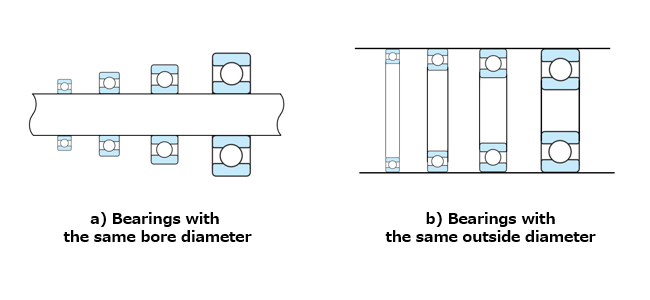
Fig. 9: Bearings with the same bore diameter or the same outside diameter
Reference: Dimension series diagrams of radial bearings and thrust bearings
4) Select the bearing of diameter series 0, 2, or 3 from the example of Table 3. If the bearing installation space is limited due to the down-sizing of the machine, select a bearing of diameter series 9.
If the installation space is limited only in the radial direction, select a bearing with a width (or height in the case of a thrust bearing) series 2 or higher, or a double-row bearing. The width series is omitted for some bearing types (such as deep groove ball bearings), so please check the Ball & Roller Bearings Catalog for details. At this stage of selecting the bearing type, it is best not to limit yourself to one type, but to select multiple types.
5. Confirm the type of the bearing you select
Check that the type of bearing you have selected is generally appropriate by using the "Performance comparison of bearing type" (Table 4).
Table 4: Performance comparison of bearing type
| Deep groove ball bearing | Angular contact ball bearing | ||||
|---|---|---|---|---|---|
| Single-row | Single-row | Double-row | |||
 |
 |
 |
 |
||
| Load resistance |
Radial load |
 |
 |
 |
|
| Axial load |
  |
  |
  ※ ※ |
  ※ ※ |
|
| Combined load |
 |
 |
 |
 |
|
| Vibration or impact load |
 |
 |
 |
 |
|
| High speed adaptabllity |  |
 |
 |
 |
|
Performance comparison of bearing type
Check that the type of bearing you have selected is generally appropriate by using the "Selected bearing type checklist" (Table 5).
Table 5: Bearing selection checklist
| Order | Examination item | Major points to confirm |
|---|---|---|
| ① | Bearing type | What magnitude and direction of load do you need? Will it fit in the installation space? <This is the focus of Part 4> |
| ② | Bearing arrangement | Are you using two (or more) bearings on a single shaft? |
| ③ | Bearing dimensions and service life | Do the dimensions and service life satisfy your needs? |
| ④ | Bearing limiting speed, running accuracy, fits and internal clearance | Does it have the necessary running accuracy and rigidity for the machine? Does it have the fits and internal clearance to satisfy its service life? |
| ⑤ | Bearing preload and rigidity | Does it have the necessary rigidity for the machine? |
| ⑥ | Bearing lubrication | Can the bearing rotate stably over a long period of time? |
| ⑦ | Components around the bearing | What bearing surrounding structure/assembly are you looking for? |
| ⑧ | Bearing mounting and dismounting | Will it facilitate maintenance/inspection of the machine? |
6. Conclusion
When selecting the bearing that is right for your machine, it is important that the bearing be appropriate for the requirements of the usage environment and that it be easily acquired for replacement. In the "How to Select the Right Bearing" columns, we will show you how to do this.
In this month's column, "How to select the type of bearing," we conveyed the following points:
- Select the right bearing type based on the magnitude and direction of the load.
- Select a bearing that matches the dimensions of the shaft or housing from the bearing boundary dimensions table.
- Check that the type of bearing you have selected is appropriate by using the "Performance comparison of bearing type" with the bearing usage criteria.
